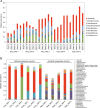Trophic networks improve the performance of microbial anodes treating wastewater
- PMID: 31583110
- PMCID: PMC6764952
- DOI: 10.1038/s41522-019-0100-y
Trophic networks improve the performance of microbial anodes treating wastewater
Abstract
Microbial anodes represent a distinct ecological niche that is characterized mainly by the terminal electron acceptor, i.e., the anode potential, and the substrate, i.e., the electron source. Here, we determine the performance and the biofilm community of anode microbiomes while using substrates of increasing complexity (organic acids or organic acids and sugar or real domestic wastewater) to mimic different, practically relevant, trophic levels. α-Diversity values increased with substrate complexity. In addition, the higher abundance value of Deltaproteobacteria in the biofilms corresponds to higher reactor performance (i.e., COD removal, current density, and Coulombic efficiency). In reactors exploiting real wastewater, the diversity of the planktonic microorganisms was only little affected. Microbiome network analysis revealed two important clusters for reactor performance as well as performance-independent pathogen-containing clusters. Interestingly, Geobacter was not found to be integrated in the network underlining its outstanding individual ecological role in line with its importance for the efficiency of the electron harvest for all reactors. The microbiome analysis of different trophic levels and their temporal development from initial colonization to stable treatment demonstrate important principles for the implementation of microbial anodes for wastewater treatment.
Keywords: Applied microbiology; Environmental microbiology.
© The Author(s) 2019.
Conflict of interest statement
Competing interestsThe authors declare no competing interests.
Figures





References
-
- Nielsen PH, Raunkjær K, Norsker NH, Jensen NA, Hvitved-Jacobsen T. Transformation of wastewater in sewer systems—a review. Water Sci. Technol. 1992;25:17–31. doi: 10.2166/wst.1992.0111. - DOI
-
- Korth B, Maskow T, Günther S, Harnisch F. Estimating the energy content of wastewater using combustion calorimetry and different drying processes. Front. Energy Res. 2017;5:23. doi: 10.3389/fenrg.2017.00023. - DOI
-
- Kumar A, et al. The ins and outs of microorganism–electrode electron transfer reactions. Nat. Rev. Chem. 2017;1:0024. doi: 10.1038/s41570-017-0024. - DOI
Publication types
MeSH terms
Substances
LinkOut - more resources
Full Text Sources

